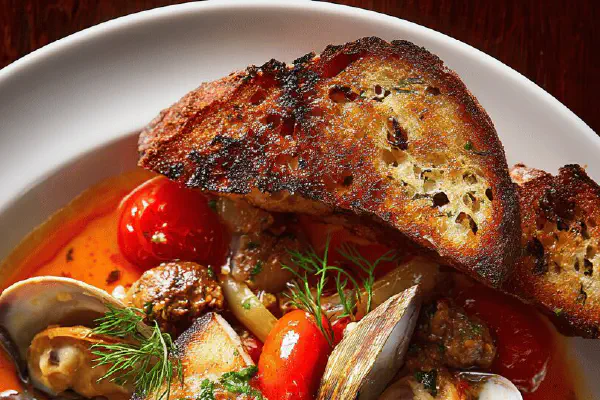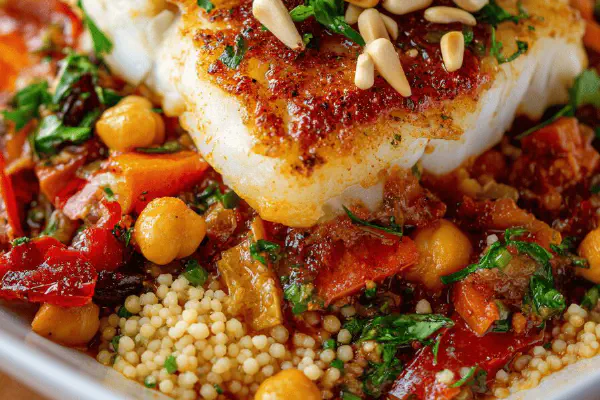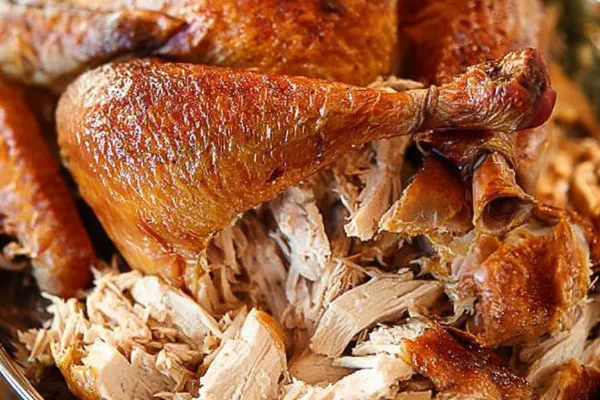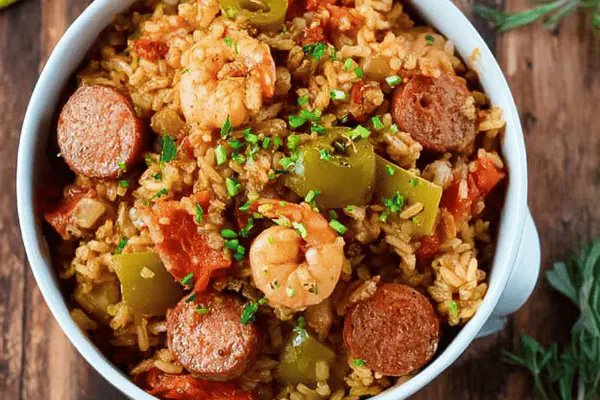Sicilian-Style Walleye Clams

By Emma
Certified Culinary Professional
Ingredients
Red Pepper Coulis
- 4 red bell peppers, halved
- 150 ml (5 fl oz) olive oil
Fish and Clams
- 250 g (9 oz) walleye fillet, skin removed, halved
- 40 g (3 tbsp) unsalted butter
- 35 ml (2 1/2 tbsp) olive oil
- 1 small zucchini, diced
- 1 small fennel bulb, diced
- 100 g (3/4 cup) cherry tomatoes
- 25 ml (1 1/2 tbsp) capers
- 25 ml (1 1/2 tbsp) pitted Kalamata olives, rinsed
- 8 g (1/4 cup) flat-leaf parsley leaves
- 1 clove garlic, minced
- 1 pinch crushed red chili flakes
- 600 g (1 1/3 lbs) small clams, cleaned
- 150 ml (2/3 cup) dry vermouth
Garnish
- 200 ml (3/4 cup) roasted red pepper purée
- 6 parsley leaves
- 6 toasted slices of rustic bread
About the ingredients
Method
Roasted Red Pepper Purée
- Set oven rack close to broiler. Preheat broiler to high. Line baking tray with foil.
- Lay peppers skin side up, roast 12–14 minutes. Watch closely; skins should blister black but not burn. Remove tray; place peppers in sealed bowl or zip bag to steam 7–8 minutes. Steam loosens skins, makes peeling easier.
- Peel skins carefully—use fingers or paring knife. Don’t waste the juices. Discard seeds and membranes; only flesh goes in purée.
- Heat 25 ml oil in saucepan over medium. Add pepper chunks, cook stirring occasionally till edges stick and start to caramelize, about 8 minutes. Helps deepen flavor with some browning.
- Blend in blender until velvety smooth. Stream in remaining oil slowly, emulsify to glossy finish. Salt to taste. Keep chilled; reheat gently before plating.
Fish and Clams
- Pat fish dry, season salt both sides. Dryness prevents steaming; you want browning.
- Heat half butter and half oil in heavy skillet over medium-low until shiny and just turning golden, around 2 minutes. Butter sizzles differently; smell nutty, signals readiness.
- Place fish, skin side up (no skin here, so just one side), cook 4 minutes undisturbed. Spoon hot fat on top every minute to cook evenly, maintain moistness.
- Flip carefully, cook 4 more minutes same way. Adjust heat if fat browns too fast; too hot burns butter and ruins flavor. Remove fish; keep warm wrapped loosely with foil.
- To pan, add zucchini and fennel. Stir over medium heat until veggies soften and get golden spots, about 6 minutes. Don’t crowd pan; veggies sweat then roast for depth.
- Season lightly while cooking—salt and pepper; draws moisture out, concentrates flavor.
- Add cherry tomatoes, capers, olives, parsley, garlic, and chili flakes. Toss quickly; tomatoes start releasing juice.
- Nestle clams in pan; splash vermouth over. Increase heat and cover immediately.
- Listen for popping clams within 4–7 minutes. Opened ones are good; pull any unopened after 7 minutes to avoid grit or chalky taste.
- Remove lid carefully—steam is hot and sharp. Stir in remaining butter off heat, whisk vigorously to create shiny, silky sauce. Butter finish binds flavors, adds richness.
- Return fish gently to pan to warm through 1–2 minutes, spoon sauce over.
Assembly
- Spread a large spoonful of red pepper purée on each shallow bowl or plate.
- Spoon clam and vegetable mixture over coulis in a rustic heap.
- Place fish fillets on top, pour remaining buttery juices generously over.
- Scatter fresh parsley leaves. Drizzle with a bit of high-quality olive oil for sheen and aroma.
- Serve immediately with toasted rustic bread slices to soak up sauce. Focaccia can substitute but toast slices for texture contrast.
Tips and Substitutions
- Swap walleye for cod, halibut, or sea bass if needed. Thicker fillets require slight cooking time adjustments; judge by opacity and firmness.
- Clams can be replaced with mussels—clean well, discard broken shells.
- Dry vermouth lends a herbaceous hint; dry white wine works fine but vermouth adds complexity.
- Got too much sauce? Chill and use next day over grilled vegetables or pasta.
- Use garlic sparingly; it should flavor but not overpower the clam essence.
- If peppers are poorly roasted or bland, add a pinch smoked paprika to the purée for warmth.
- Mistakes: Overcooking fish turns it dry and dull; watch for that subtle flake-y feel and milky opaqueness.
- Clams toughen if overcooked and release grit if not cleaned thoroughly—soak long in cold salted water, change water twice.
- Butter off heat avoids splitting, important when you add at end to emulsify juices.
- Overall, balance briny, sweet, and spicy with texture — tender fish, chewy clams, crunchy veggies.
Cooking tips
Chef's notes
- 💡 Roasting peppers needs sharp eye—black blistered spots, not burned. Steam right after roasting to loosen skins effortlessly. Peeling without the steam is a pain and messes texture. Juice from peppers holds flavor; keep it in the purée. Browning pepper edges adds depth without bitterness. Slow drizzle oil into blender helps emulsify; don’t rush or the purée splits. Salt last since flavors concentrate with chilling. Use leftover purée next day, reheated gently avoid breaking sauce texture.
- 💡 Fish dryness crucial for control over browning; pat thoroughly both sides before seasoning lightly with salt. Use medium-low heat mix of butter and olive oil. Nutty aroma signals butter is ready; small bubbles, no dark spots. Spoon fat repeatedly beats dryness and builds flavor layers accidentally. Flip gently to keep fillet intact. Adjust heat on browning speed—too hot kills butter, flavor and texture deteriorate. Remain patient and precise, the difference shows fully on palate and plate.
- 💡 Vegetables want room; crowding leads to steaming, no caramelization, dull veggies. Zucchini and fennel soften then get light golden edges, aroma shifts earthier, focus on texture—shouldn’t go limp or mushy. Season with salt and pepper while cooking—draws moisture out, boosts flavor intensity naturally. Add tomatoes, capers, olives fast to keep acid and brine upfront, with some burst juice locking fresh balance. Timing here is juggling, but color and smell are guides.
- 💡 Clams are swift but unforgiving. Clean thoroughly or grit wrecks dish. Soak in cold salted water, change water twice for grit release. Steam covered with vermouth splash pushes opening fast but within 4–7 minutes max. Listen for popping shells. Overcook and clams toughen, flavor dulls noticeably. Pull any unopened after 7 minutes to avoid chalky bite. Off heat add butter whisk vigorously for silky bind to pan sauce, finishing it off properly makes all difference in mouthfeel and richness layering.
- 💡 Assembly is layering in visual and texture contrast. Spread purée thick but not gloppy, rustic not slick. Heap clam-veggie mix roughly for rustic look. Fish fillets gently placed on top, then pour remaining buttery sauce generously. Fresh parsley sprinkled on — bitterness and freshness cut richness, and drizzle olive oil last for aroma and sheen. Toasted rustic bread catches sauce and juiciness for eating. Sub steamed focaccia but separate texture needed against soft fish and stewed veggies for contrast.
Common questions
Can I use other fish instead of walleye?
Cod, halibut, sea bass swap fine. Thicker fillets need timing tweaks watch opacity and flake. Lean fish for gentle cooking. Adjust by feel not just clock. Keep moisture sealed spooning butter-fat combo throughout cooking.
How to prevent clams from gritty taste?
Soak long in cold salted water minimum an hour or twice changing water. Check shells for cracks discard. Rinse well before cooking. Patience needed. Avoid shortcut or grit ruins texture. More soaking better grit removal.
What if I don’t have dry vermouth?
Dry white wine next best but vermouth adds herbal edge no wine pretty neutral. If neither, dilute white grape juice with a bit of lemon juice for body but flavor missing. Keep liquid moderate so sauce consistency stays thick and rich.
How to store leftovers properly?
Keep sauce refrigerated in airtight container separate from bread and fish ideally. Use within 24 hours. Reheat gently, low heat to avoid breaking emulsification. Clams lose texture if reheated too strong. Bread store dry or toast fresh to avoid sogginess next serving.



